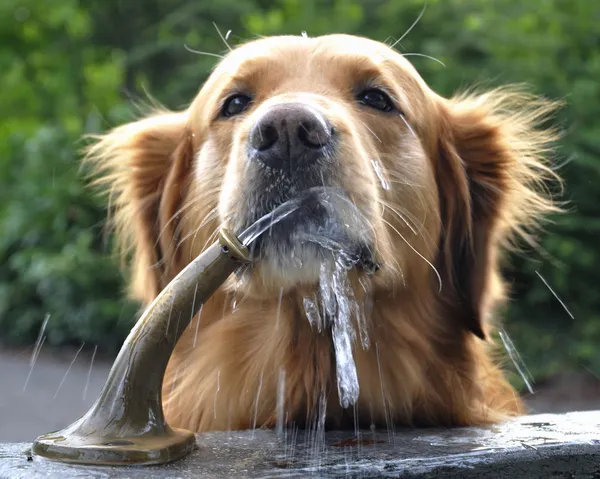Why does a dog need water?

A balanced diet for a dog is not only about the right food, but also about the right drinking habits. Water has many tasks: it regulates heat exchange, participates in biochemical reactions, including the formation of milk. If a lactating dog consumes little fluid, it can lead to dehydration. Therefore, a healthy dog will consume plenty of water during lactation. If you notice a decrease in thirst and appetite in a lactating dog, he and his puppies should be taken to the vet as soon as possible.
A dog also cools down through moisture. Moisture evaporates through saliva and from the surface of the tongue, and this helps maintain a normal body temperature. That’s why dogs open their mouths and breathe intensely when it’s hot and stuffy.
At the initial appointment at our clinic, owners and I always discuss the basics of feeding and drinking. And right now I suggest to find out if your dog is getting enough water.
How much water a dog should drink
Depending on age, activity and other parameters, the amount of fluid drunk per day varies. A Jack Russell Terrier puppy may drink proportionally more than an adult Yorkshire Terrier.
Water needs in dogs depend on a number of factors. The main ones are:
Type of diet: dry, wet, or “straight,” i.e., a home-cooked diet
Body weight: large dogs tend to drink more than miniature dogs.
Physical activity level: the more a dog moves, the more water he needs
Living conditions: Air temperature, humidity, heat
Individual differences: Pregnancy or lactation, for example
Increased thirst can occur due to medication side effects, as well as in connection with poisoning. There is also psychogenic thirst – psychogenic polydipsia. It is most often found in young dogs that have been traumatized or have experienced severe stress, such as a change of scenery or fireworks.
To make sure you don’t get the milliliters wrong, don’t forget to count the amount of liquid in the food. Let’s look at an example. Dry food contains about 10 percent moisture. That’s not enough liquid for your dog, so he’ll be thirsty and fill up on what he needs in the form of clean water from the bowl. He’ll drink a lot, and that’s okay. But if the dog eats wet food or homemade “straight food,” he will by default get more fluids from his food in a day than the dog in the first example, and he will drink less.
What happens if the dog doesn’t drink enough
If a dog drinks too much or too little, it may indicate a number of diseases. The most common and dangerous are:
- Pyometra, a purulent inflammation of the uterus;
- diabetes mellitus;
- hyperadrenocorticism;
- renal failure;
- hyperthyroidism;
- hypercalcemia;
- liver abnormalities.
Severe fluid deficiency (dehydration) worsens the overall condition of the pet. This is usually due to an acute deterioration or a long-standing chronic illness. In such cases, visit the veterinary clinic immediately.
When to sound the alarm
I recommend that every dog owner consult with a veterinary nutritionist beforehand to avoid missing an alarming symptom. He will assess your dog’s condition and determine his water and food intake at the same time. This should give you an idea of how much water your dog needs per day and if he’s on track to meet that target.
I recommend measuring the amount of fluids you drink in the same container, of which you know the exact amount. A measuring cup is a good choice. For greater accuracy, it is better to measure for 2-3 days. It is important to give the pet free access to water.
You should be worried if:
- An adult dog drinks more than 100 ml of water per 1 kg of weight, with an average level of physical activity, a comfortable environment, a mixed or wet diet
- Goes to the toilet more heavily than usual: the volume of urine increases
- Partially or completely refuses water, food and treats


